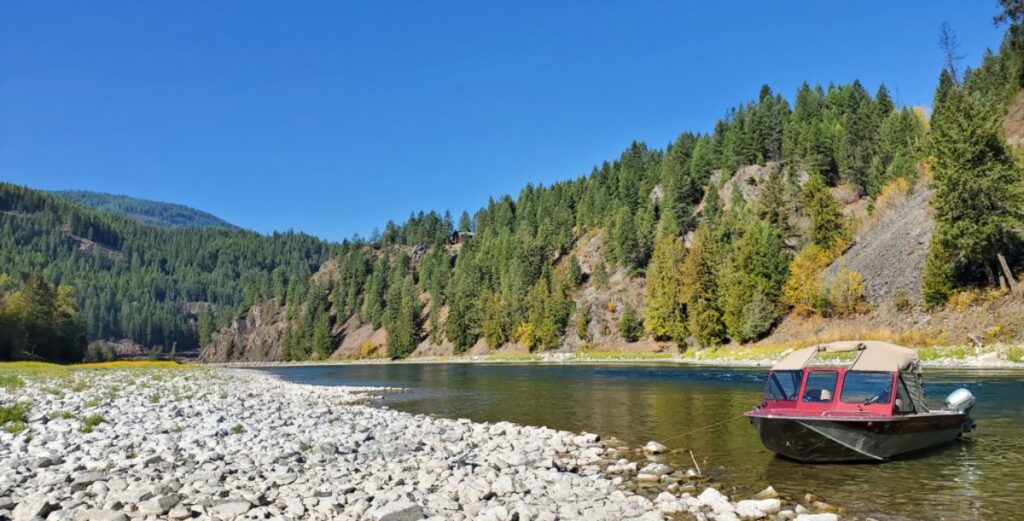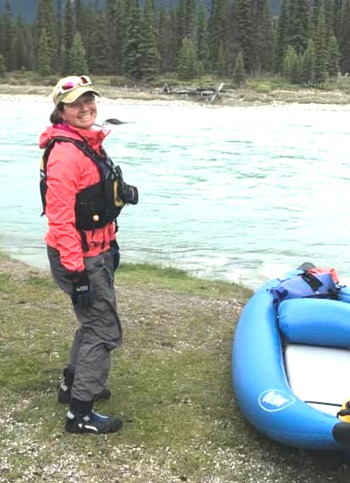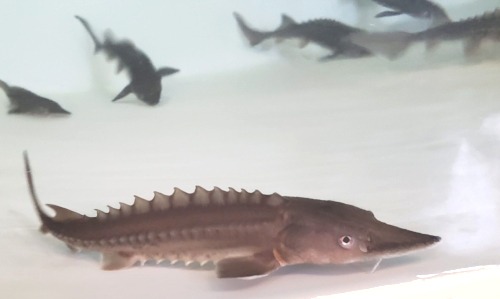
By Mia Maldonado
Idaho Capital Sun
 Members of the Kootenai Tribe have spent decades and more than $500 million since the 1980s to restore fish populations in North Idaho, and despite pleas to lawmakers and mining companies, they say nothing is being done to stop the further pollution of the Elk River, where increasing mineral levels threaten fish and human populations. The Elk River is connected to five mountaintop removal coal mines near Fernie, British Columbia, about two and a half hours from Bonners Ferry. It feeds into the Kootenai River, which flows through Montana and Idaho.
Members of the Kootenai Tribe have spent decades and more than $500 million since the 1980s to restore fish populations in North Idaho, and despite pleas to lawmakers and mining companies, they say nothing is being done to stop the further pollution of the Elk River, where increasing mineral levels threaten fish and human populations. The Elk River is connected to five mountaintop removal coal mines near Fernie, British Columbia, about two and a half hours from Bonners Ferry. It feeds into the Kootenai River, which flows through Montana and Idaho.
The Elk Valley has one of the highest quality deposits of metallurgical coal in the world, which is the type of coal used in steelmaking.
Long before the U.S. government recognized the Kootenai Tribe of Idaho, Ktunaxa people lived on 27,000 square miles of land across the Rocky Mountains and the Great Plains of the U.S. and Canada. But the establishment of the U.S. and Canadian border split the Ktunaxa people into seven communities: five tribes in British Columbia, and two in the U.S. — the Kootenai Tribe of Idaho, and the Confederated Salish and Kootenai Tribes of the Flathead Reservation in Montana.
Despite the presence of government borders, the Ktunaxa people continue to collaborate in addressing cross-border issues in their community. One of the Ktunaxa Nation’s top concerns is coal mining pollution stemming from British Columbia’s Elk Valley.
One mineral – selenium – is the greatest concern for conservation groups, and it is commonly linked with the rock found adjacent to coal. Selenium is found naturally in foods and soil and is a necessary mineral for health, but excessive intake can be toxic. During the mountaintop removal mining process, the mountains are exploded open with dynamite to access the coal, but bringing selenium-rich rock with it. When the rock is exposed to rain and air, the selenium dissolves into nearby waterways.

Genny Hoyle, the environmental director for the Kootenai Tribe, said in 2015, she began noticing an increase in selenium levels below Libby Dam and into Kootenai Lake. In 2015, she said about 0.1 micrograms of selenium per liter were present below Libby Dam. But in November, she said most recent lab reports show that selenium levels were at 1.3 micrograms per liter.
Idaho and Montana’s Department of Environmental Quality have set the selenium limit for the Kootenai River below Libby Dam at 3.1 micrograms per liter. While the Kootenai Tribe is not seeing selenium levels above that threshold, Hoyle said she has noticed a gradual increase over time, which poses a risk to fish populations. Hoyle has been researching the Flathead Basin and northwest Montana since 2006. She also has represented the Confederated Salish and Kootenai Tribes on transboundary mining issues for over a decade.
“We’re seeing exceedances in fish tissue and egg ovary concentrations in a number of our fish species, which is concerning,” she said. “What that highlights is that I don’t think 3.1 (micrograms) is protective of Kootenai River aquatic life.”
Selenium, she said, is sometimes called “the silent killer,” because it works its way up the food chain and can cause reproductive and growth impairments. High selenium levels cause larval egg and larval deformities, so even if eggs hatch, the larvae can be so deformed that they fail to thrive and die, she said.
And Hoyle said some fish, like burbot and white sturgeon, are more sensitive to the presence of selenium than others.
“The Kootenai has such an amazing, diverse ecosystem, and it’s at the cusp of being horribly degraded,” Hoyle said. “The Kootenai Tribe is not against mining. What we would like to see happen is that the appropriate mitigation is implemented at the appropriate scale.”
British Columbia is home to Teck Resources – the second largest seaborne exporter of steelmaking coal, according to the company’s website. Coal mined by Teck Resources is used to make steel for building and transportation infrastructure.
As reported by Canadian news outlet, The Narwhal, Teck’s coal business is the largest employer in the Elk Valley. In 2019, it contributed about $4.9 billion to British Columbia’s GDP, which is roughly 60-percent of the province’s mining sector GDP.
Teck spokesperson Chris Stannell told the Idaho Capital Sun that in 2013, the company developed the “Elk Valley Water Quality Plan,” a long-term plan designed to stabilize and reverse the trend of selenium and other contaminants in the watershed. The plan, he said, was established in collaboration with U.S. agencies, tribes, local and provincial governments and scientists.
Stannell said Teck has built four water treatment facilities treating 77.5 million liters of water per day, and the company plans to increase its treatment capacity to 150 million liters per day by 2027.
In an email, Stannell said the company removes between 95- to 99-percent of selenium from treated water.
“We have invested over $1.4 billion towards water quality monitoring, management, research and construction of treatment facilities to date with plans to invest a further $300 to $400 million by the end of 2024,” Stannell said. “We are constantly researching new technology, and have more than 25 research and development projects underway to help reach our water quality goals.”
In a press release from the Ktunaxa Nation in October, leaders proposed a referral of the issue to the International Joint Commission, which resolves water disputes between the U.S. and Canada. The Ktunaxa Nation says a referral to the commission would allow for a scientific assessment of pollution in the watershed and allow both federal governments and the Ktunaxa people to implement water restoration solutions and ensure more regulation of the watershed.
Members of the U.S. Congress have previously expressed concern about selenium pollution, including in 2019, when congressional leaders from Montana, Washington, Alaska and Idaho sent a letter to Canadian officials expressing concern over the “the lack of oversight of Canadian mining projects near multiple transboundary rivers,” States Newsroom previously reported.
The 2019 letter included signatures from U.S. Senators Jim Risch and Mike Crapo, both Idaho Republicans. But since then, Idaho’s congressional delegation has not provided further support for a referral to the commission.
Risch, a ranking member on the foreign relations committee, did not respond to the Idaho Capital Sun’s question about his stance on the issue.
Erin Sexton, a senior scientist with the University of Montana, said it is hard to watch the contamination issue go on for so long and be “completely ignored.”
“I’m at the point personally and professionally where I feel like it’s time for the governments of Idaho, Montana, the tribes and First Nations and the U.S. and Canada to come together and meaningfully show that they are interested in the health of this watershed,” she said.
Sexton said selenium levels in Koocanusa Reservoir, the U.S.-based reservoir that is part of the Elk River watershed, also exceed the standard, and there are several species of fish with excess selenium in their tissue.
“There isn’t any reason for us to not be encouraging protection of the Kootenai River and Koocanusa Reservoir, because we don’t have any benefits of those mines downstream here,” she said. “It’s just all cost for us.”
Conservation groups in Canada and Idaho are not satisfied with Teck’s water quality plan.
Randal Macnair, the Elk Valley conservation coordinator for Wildsight, a Canadian conservation organization, said increased selenium contamination has started jeopardizing human health.
“Sparwood, a (British Columbia) community close to the mines, had to have one of the drinking water wells taken offline because it exceeded the selenium limits for human health,” he said in a phone interview. “It’s impacting people in a very real way in our communities.”
Additionally, one of two drinking water wells in Fernie was shut down because of exceeding selenium levels, he said.
Macnair said Teck has failed to properly implement its Elk Valley Water Quality Plan, which he said is clear after the company was fined $60 million in 2021 by the Provincial Court of British Columbia on Friday for polluting waterways in the Elk Valley, and $16 million in February for not building a water treatment facility on time by the required permit date.
“We feel the oversight from Canada’s provincial and federal governments has been inadequate,” he said. “They’ve had two and a half decades to deal with this, and it’s not working. So ourselves and the Ktunaxa have been asking for the International Joint Commission to oversee the entities in this watershed.”
Macnair said that the Elk Valley is similar to parts of North Idaho and Montana, where mining played a large role in the region’s history, but it has since transformed into a tourist hub for outdoor recreation.
“This is a multigenerational problem that we’re talking about,” Macnair said about the mining contamination. “This is something that’s going to be an environmental problem for centuries to come, and it’s going to be impacting people in the Elk Valley, and down into Idaho for centuries to come.”

Jennifer Ekstrom, the North Idaho lakes conservation associate for the Idaho Conservation League, told the Sun that the league is also supporting the Ktunaxa Nation’s request to refer to the International Joint Commission.
“Not only are these mines polluting the water in Montana and Idaho, but these mines are also emitting carbon into the air that is exacerbating climate change,” she said, adding that much of the coal extracted is shipped to countries in Asia.
Ekstrom said she believes now is an important time for the International Joint Commission to get involved in the issue, as another mining corporation, Glencore, is attempting to purchase the coal mines from Teck Resources.
“Before that sale happens, it would be really important to have International Joint Commission involvement to ensure that those protective measures and a plan for cleaning up the pollution is in place,” she said. “This is an archaic industry, and it’s time that we look into a brighter future and make the changes that we need to make to support the health of our planet in perpetuity.”
Shawn Young, the fish and wildlife director at the Kootenai Tribe, told the Idaho Capital Sun that when Libby Dam was constructed in 1975, burbot and young white sturgeon fish species were almost entirely wiped out within 10 years. With the help of funding from Bonneville Power and resources from the University of Idaho, the tribe restored burbot populations from 50 to 100 in the mid-90s to 50,000 fish in 2023.
“The Tribe has a connection to nature, the land, and the ecosystem that’s been continuous for so long,” Young said. “There’s a bond, and it’s a part of who they are and who they are and who they will be.”
The Kootenai River is also home to white sturgeon, which was listed as an endangered species in 1994. Sturgeon are also included in the Kootenai Tribe’s restoration efforts.
“Sturgeon are extremely important to the Ktunaxa Nation,” he said. “This is the central part of the ecosystem and that’s always been their main ancestral home and territory.”
While the hatchery program has been a success in keeping sturgeon and burbot from extinction in the region, it has not solved the problem of natural recruitment, or surviving without human intervention.
Aside from the challenges posed by dams, Young said the Tribe is witnessing fish contaminated by pollutants from coal mining in the Elk Valley.
Young said that there is no short-term solution to the issue, and that the mining contamination will go on to impact several generations. He is hopeful that the Tribe will find a way for the fish to reproduce naturally, but coal mining in the Elk Valley is a primary threat to that hope.
“It jeopardizes everything that the folks before me, what I’m trying to do, and the folks that are going to come after me,” Young said about coal mining contamination. “It is that serious, so it’s very disappointing that nobody has stepped up to properly address it.”
Idaho Capital Sun is part of States Newsroom, a network of news bureaus supported by grants and a coalition of donors as a 501c(3) public charity. Idaho Capital Sun maintains editorial independence. Contact Editor Christina Lords for questions: info@idahocapitalsun.com.
